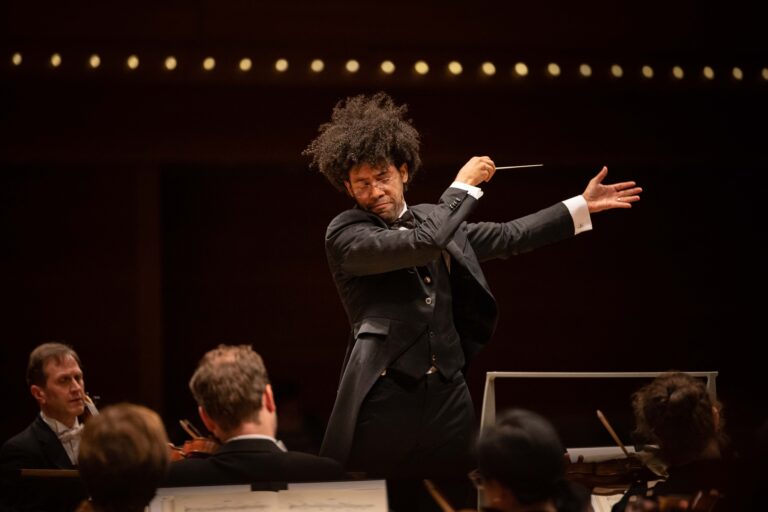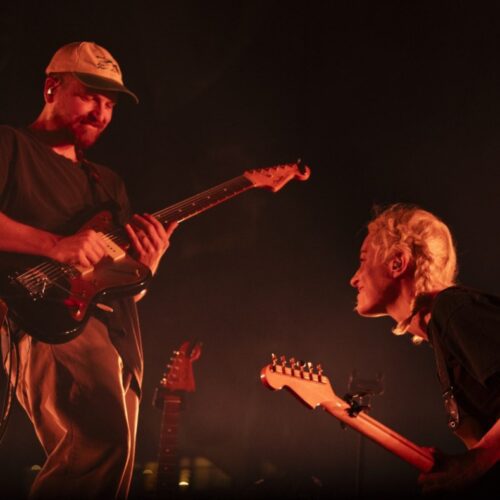The PAN M 360 team is very present at the Virée classique, presented by the MSO. Our contributors report daily on what they have seen and heard at the concerts presented in Montreal until August 20.
Virée classique 2023: A Program Full of Surprises and Discoveries!

Virée classique is now in its 10th year. The program offers a space for storytelling and unexpected encounters. Program managers Marianne Perron and Ronald Vermeulen gave us an overview of the events on offer indoors and free of charge. They promised us a diverse and excellent tour (in fact, a marathon) from start to finish, but pointed out a few must-see events: performances by the Obiora ensemble, Carmina Burana conducted by Rafael Payare, Monteverdi’s Vespers of the Virgin and the Canadian premiere of Wynton Marsalis’ trumpet concerto.
This edition of Virée classique, an urban and accessible celebration of classical music, also features forays into so-called classical music from around the world. Of particular note are the gamelan series, and performances by the Oktoecho ensemble. A special place is also reserved for amateur musical practice. Several youth ensembles and non-professional musicians will take to the stage throughout the weekend.
These three days promise to be full of (re)discoveries and wonderful musical moments!
Elena Mandolini
Installations That Bring the Orchestra to You!

La Virée classique isn’t just about concerts in the concert halls or on stage. It’s the entire Place des Arts that comes to life, brought to life by the love of classical music from here and abroad! This cultural vivarium is sustained by an almost unstoppable stream of concerts from Friday evening to Sunday afternoon, as well as by activities dotted around the space.
The Salon urbain, opposite the Maison symphonique, is home to a highly interesting exhibition that is making a comeback for the 2023 edition of La Virée. “Les instruments sortent de l’orchestre” is an opportunity to learn more about the instrumentation of a symphony orchestra. The booths are staffed by experts from specialized workshops, who are able to educate visitors on the particularities of each instrument family. There’s a fine array of wind instruments and a good demonstration of the violin-making process, as well as an amusing assortment of percussion instruments. Casavant Frères organs, meanwhile, celebrate the upcoming 10th anniversary of the Pierre-Béique organ at the Maison Symphonique.
Another installation of note is its section devoted to virtual reality experiences, at Espace Sainte-Catherine just to the left of the Place des Arts entrance. Two experiences are available: Partitura, where you take on the role of an orchestra conductor, and Innere Musik, which transports you to the heart of the Maison symphonique organ. There seems to be something for everyone, children and adults alike.
Alexis Ruel
Virée classique 2023 : Behind the Camera With Film Music
For those who are passionate or simply curious about the musical aspect of the 7th art, yesterday saw the presentation of a pleasant conference on the secrets (well or less well kept) of film music. Hosted by Marie-Claude Codsi, herself a composer and doctoral student on the subject, the 45-minute talk revealed a little more about the musical realm of Korngold, Herrmann (unfortunately absent from the presenter’s examples), Williams, Zimmer et al. The OSM space, located right next to the entrance to the Maison symphonique, was packed with an attentive audience. The host gave a rather succinct overview of the history of the medium. But Ms. Codsi made the most of the short time allotted to her, providing interesting anecdotes and even sharing a compendium of which I was unaware: a large book dating back a century (in truth, a copy, but still…) in which dozens of scores were listed according to mood, emotion or scenic situation (chase, fall, plane, night, etc.). It was used by the musicians who accompanied the screenings of the first silent films! Fascinating! Audiences also had the rare opportunity to see an example of an iconic film scene (here, the finale of Star Wars Episode IV) WITHOUT its music. Wow. For many, it was a revelation of the importance of this dimension of cinematic art. A few notions of Mickey-Mousing, Temp Tracks, Punch and Streamer rounded out a film music 101 course that showed viewers that this music, after more than a century of existence, has a lot of substance and deserves to be respected.
Frédéric Cardin
Melancholy Birds and Romantic Lyricism With Noémie Raymond-Friset and Zhenni-Li Cohen

Birds have made their nest at Place-des-Arts’ Espace culturel Georges-Émile Lapalme. Cellist Noémie Raymond-Friset, accompanied by pianist Zhenn-Li Cohen, introduced the first part of this hour-long concert prefiguring Rachmaninov’s Sonata for Cello and Piano. To open the concert, the two musicians performed Saint-Saëns’s Le Cygne with languorous, energetic and ethereal energy. With similar melodic lines and harmony, albeit more dramatic, they followed with Villa-Lobos’s Le Cygne noir, before concluding the first part of the concert with Pablo Casals’s Le chant des oiseaux, an arrangement of a Catalan folk song: a nostalgic lullaby. The pièce de résistance of the performance, Rachmaninov’s Sonata, contemporary with his famous piano concerto, was composed, as presented by Noémie Raymond-Friset, in the wake of a depression following the disastrous reception his first symphony had received. Sadness, anger, joy – all these raw emotions were put into the score by the composer, and were aptly translated by the duo of musicians through a rigorous, supple touch on the piano and expressive, energetic lines on the cello. We must salute Noémie Raymond-Fiset’s concentration in a performance setting less formal than that of concert halls, where the open aspect of the stage offers a slight distraction from the surrounding noise. At times, the setting made it difficult to appreciate the character of the piece, and we felt that the performers had to adjust the volume a few times. These minor details aside, the fine performance by Noémie Raymond-Friset and Zhenn-Li Cohen caught the eyes and ears of a hundred passers-by.
Alexandre Villemaire
A Musical Incursion Into the World of Words
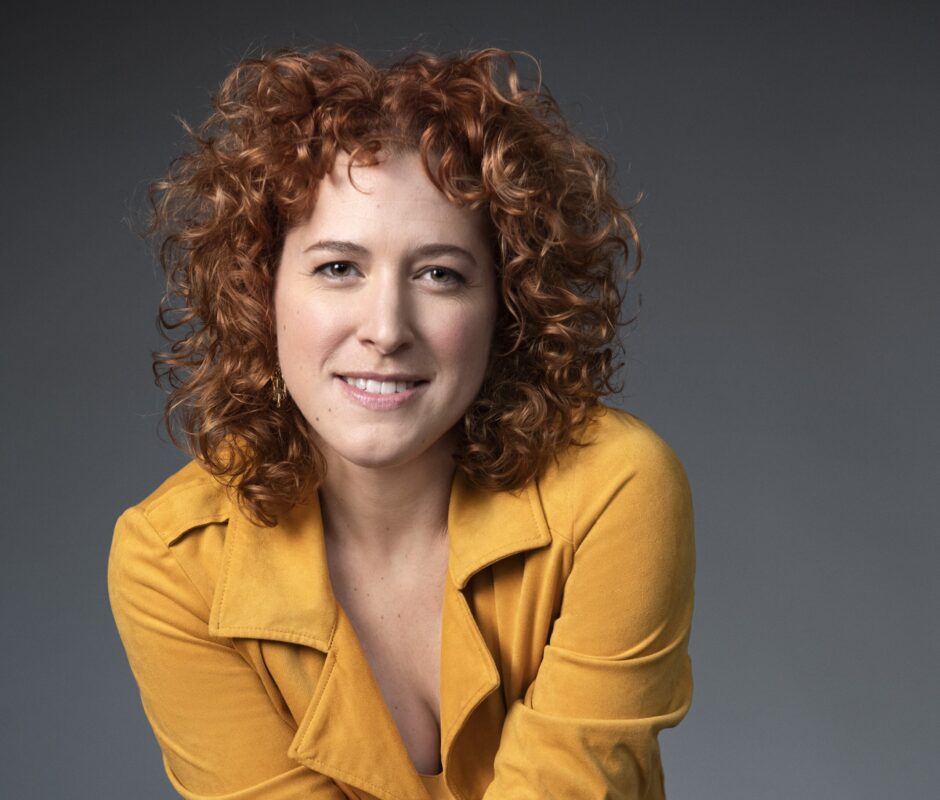
Photo credit: Laurence Labat
Music and literature go hand in hand, and sometimes more often than you think. This is what Katerine Verebely, host and cultural columnist for Radio-Canada radio, points out in her listening club. Since two other sessions of this listening club will take place over the weekend, we won’t spill the beans to our readers who wish to participate in the near future. We’ll just say this: there are some great musical discoveries to be made at this listening club! Thanks to Katerine Verebely’s obvious passion for the subject, we’re discovering rare gems and well-kept secrets from the classical repertoire, past and present. Literature also takes pride of place. We (re)learn poems, stories and literary forms.
As the host so aptly puts it, the links between music and literature are like a thread that can be pulled endlessly, without ever running out. Come and discover this richness at Virée classique!
Elena Mandolini
Les Petits chanteurs du Mont-Royal Take Us on a Journey!
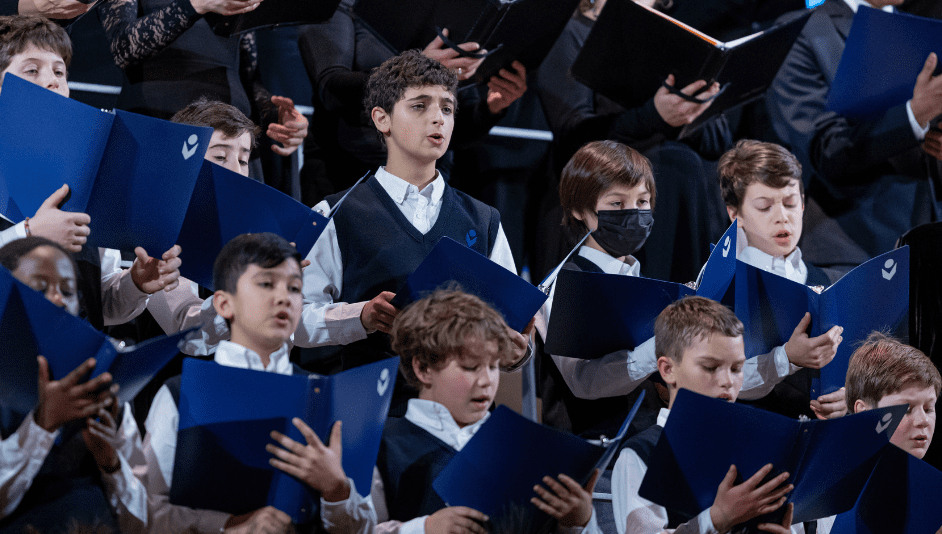
A procession of some forty youngsters, ranging in age from eight to seventeen, offered spectators at the Esplanade Tranquille on Friday evening a truly remarkable experience. The Petits chanteurs du Mont-Royal, a youth education program offering advanced musical training to young people from all walks of life, explored South American choral repertoire with unity and cohesion that was out of this world, echoing their tour there earlier this year.
Their liturgical experience was immediately apparent, particularly in the precision of the melodic lines and the complex polyphony present in many of the works. The younger members shared the soprano and alto lines, while the older ones filled out the tenor lines. In addition to the predominantly religious repertoire, some of the popular tunes were performed to great effect, with some amusing surprises such as the imitation of instruments, accompanied by mimed gestures!
The relatively low volume of the voices created an atmosphere of contemplation for a varied audience, ranging from young families to more seasoned ears. It’s certain that the audience as a whole appreciated these angelic voices, which more than once impressed and even thrilled!
Alexis Ruel
5ilience: A Wind Quintet Against the Wind
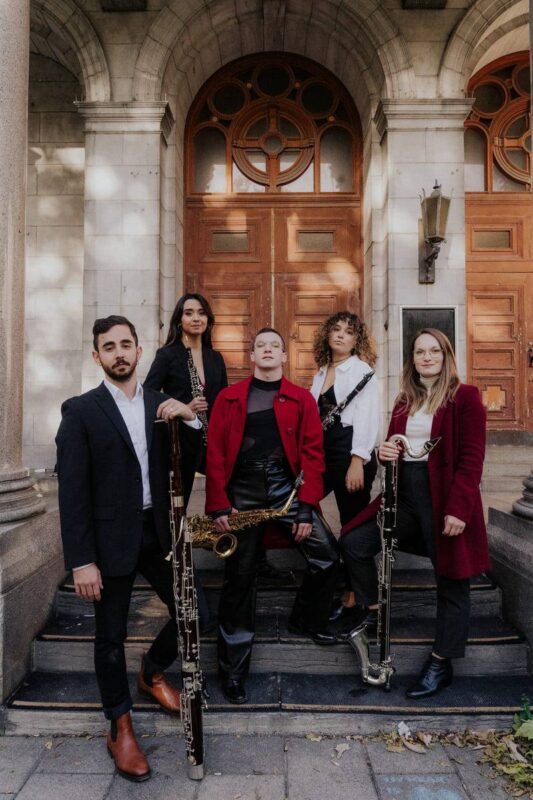
Quebec’s first reed quintet, the ensemble 5ilience inaugurated its participation in Virée classique with a modern and contemporary repertoire… in the wind! While there was no reason to fear that rain would be a spoilsport on the first day of Virée’s free outdoor programming, this was not the case as we passed through Sainte-Catherine at 7 pm. Instead, some nasty squalls got in the way, causing a few problems with instrument amplification and on-stage logistics. Hats off to Léanne Teran-Paul (oboe) and Mary Chalk (bassoon), who were solid despite the fact that their scores were somewhat disturbed, despite the ties that had been attached to their lecterns! Notwithstanding this untimely breeze, the musicians of 5ilience presented with conviction and aplomb five works offering a diverse panorama of the timbral palette that the ensemble can offer. Presenting new music, often contemporary, in a free program is quite daring, and the ensemble has succeeded in building a program that is both accessible, with pieces such as Danses galactiques (2022) by Simon Bourget, with its film-music-like language, or “Le pin” extracted from Marc Mellits’ Splinter cycle (2014), with its groovy character, which counterbalanced more cutting-edge pieces such as “Goat Rodeo” from David Biedenbender’s Refraction suite (2015), described by clarinettist Mariane Pellerin as “a mix of funk, dubstep and pointillism, dubstep and musical pointillism”. Her contributions, and those of Thomas Gauthier-Lang, saxophonist and artistic director of the group, were highly relevant and playful in presenting the various pieces. Definitely an ensemble to keep an eye on in Quebec’s musical landscape.
Alexandre Villemaire
Contrast and Light at the Maison symphonique

Photo credit: Antoine Saito
The first Virée 2023 concert at the Maison symphonique, Fairytale and Mozartian Poetry, featured two stylistically contrasting works whose orchestral refinement brought out the full acoustic and sonic splendour of the Montreal venue. The opener was Fairytale Poem, a symphonic poem by Russian composer Sofia Goubaïdoulina, which combines quivering textures with sparkling sparkles and dynamic contrasts ranging from barely perceptible murmurs (is there such a thing as 18 pianissimos?) to effusive fortissimos that remain reasonable, but impressive nonetheless. The Maison symphonique was made for this kind of music: you hear everything, everything, everything. And it’s spellbinding. Goubaïdoulina’s music delighted the audience with its prismatic play on light and, above all, its flourishing woodwind lines (a specialty of the composer born in 1931).
The main course was of a completely different stylistic order: Mozart’s solar Piano Concerto No. 25, K 503, in C major. Pianist Jeremy Denk came bouncing onto the stage, looking genuinely happy to be there. So much the better. If the opening bars seemed to lack a little clarity and reveal one or two doughy digital passages, the sunshine inherent in this work regained its dominance from the four-note motif exchanged between soloist and orchestra, a motif – the detail is worth knowing – that some say anticipates that of Beethoven’s 5th symphony. From that point on, the terrain was clear. The central andante, imbued with solemnity, created a scene of a sun star gradually revealing itself and offering the prospect of a future filled with promise. The final Allegretto enshrined this optimistic vision, drawing us into a radiant harvest where the fruits of previous promises could be fully reaped. Denk played with joy and spontaneity, characters to which an attentive OSM and a complicit Rafael Payare added their technically applied participation.
Frédéric Cardin
Dramatic Stories and Captivating Music

Part of the charm of La Virée classique is that the programs are short and sweet, but tonight I wished the show kept going. It was a truly enchanting evening of chamber music at the Piano Nobile thanks to the exquisite musicianship of Olivier Thouin, Todd Cope, and François Zeitouni, on violin, clarinet, and piano respectively. Together they navigated a captivating repertoire, weaving together the rich narratives of Milhaud, Stravinsky, and Srul Irving Glick.
With his warm demeanour, Olivier explained the selections and gave us a sense of what to listen for in the movements. The repertoire was very accessible, and the band did well to bring out the playful folk-like aspects of Milhaud and Stravinsky’s compositions while also showcasing their virtuosic prowess, bordering on devilish at times. The highlight of the evening was of course Stravinky’s Histoire du Soldat. This timeless tale of a soldier’s Faustian bargain was brought to life so vividly that perhaps the actors would have been superfluous. The only frustration there was that each movement ended so dramatically it was hard to contain our applause. Glick’s vibrant The Klezmer’s Wedding saw Todd Cope taking more of the lead. The mood was dramatic and thoroughly festive, much like a wedding, and it was a fitting tribute to a Canadian icon of classical music.
Varun Swarup
A Concert for Memories: Oktoecho at Théâtre Maisonneuve

Photo credit: Antoine Saito
An ensemble with multiple influences and sources of inspiration, OktoEcho is a master in the art of surprising, moving and enchanting audiences. As soon as you entered the hall, you could feel the special touch of the music that was about to be played. The audience was on stage, almost in a circle around the musicians, creating an almost intimate atmosphere, eliminating the classic concert barriers between stage and audience. The ensemble is made up of a kanun (a Turkish plucked string instrument), a kamânche (a haunting Iranian instrument akin to the violin), an oud (origin of the guitar), two percussionists and a string section (violins, violas, cellos and double bass), was conducted by Katia-Makdissi-Warren, OktoEcho’s artistic director and founder. The orchestra was joined by two Inuit throat singers.
The concert was breathtakingly precise. Everything seemed perfect. The sounds, timbres and modes used transported the audience to the lands of the Middle East. The rhythms also contributed to this impression. Alternating between driving grooves and meditative mantras, often within the same piece. The influence of Arabic and Middle Eastern music dominates in this configuration of the ensemble. Jazz influences can also be felt in certain pieces, both in harmonics and structure. We are also witnessing a blending of origins. At several points, the instruments seem to imitate each other. This blending muddies the waters, giving way to a fascinating unity.
The most captivating aspect of the show, however, is the place that Inuit throat singing occupies in the orchestra and the score. Their incorporation into the ensemble’s music is done with an apparent respect that manifests itself in the authenticity of the contexts. To give an example, one work is devoted entirely to the fundamentally playful aspect of throat singing. The two singers and the percussionists play together, imitating each other, answering each other, exchanging and meeting for a brief moment, which ends in an endearing laugh. The third work presented, devoted to singing, remains the most gripping of the concert, demonstrating all the virtuosity of the singers and the orchestra around them. An unforgettable concert!
Alexis Ruel
The Schumanns’ Music in the Spotlight
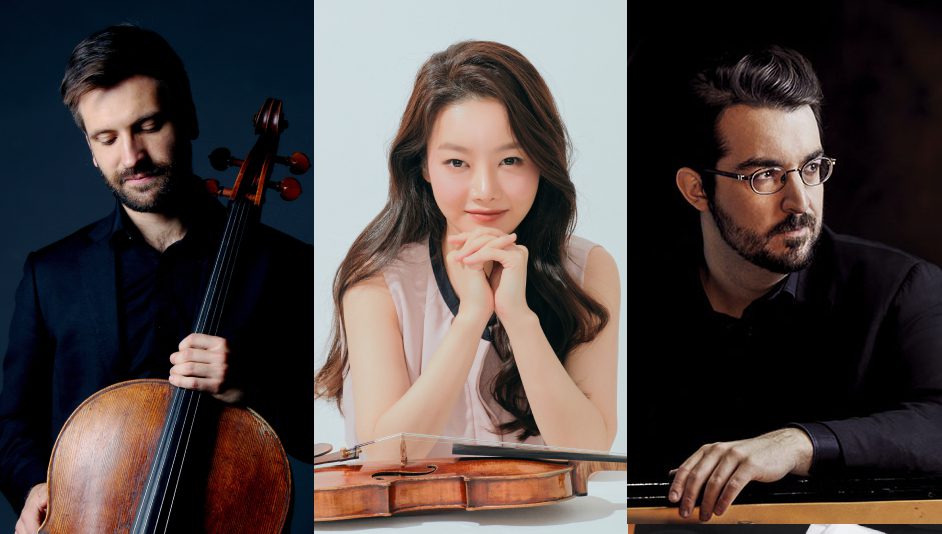
The stage of Salle Wilfrid-Pelletier at Place des Arts was transformed into a small, intimate room to accommodate a short chamber music recital. Bleachers were set up on the stage for the occasion. Charles Richard-Hamelin on piano, Bomsori on violin and Dominique Beauséjour-Ostiguy performed Three Romances for violin and piano and Trio for piano and strings, no. 3, by Clara and Robert Schumann respectively. The audience is transported to 1850, as Robert becomes increasingly ill and Clara ends her career as a composer. Despite this tragic premise, there is much light, tenderness and life in the pieces on the program.
Unfortunately, the acoustics were not optimal, so the sounds were somewhat muffled. However, nuances were not lost: the softest passages and most subtle pizzicati still reached the audience’s ears. The pieces performed are already well known, but the interpretation by the three musicians was so breathtaking and sensitive that we listened to them as if for the first time. The Romances and Trio are musically complex pieces, and the performers were able to illustrate all the changes of tone, all the energy and all the colours concealed in these works. The musicians are exceptionally talented, and listening to them is particularly captivating.
Elena Mandolini
A Dazzling Payare Accompanies an Introspective Alstaedt

Photo credit: Antoine Saito
Rafael Payare had a practically packed Maison symphonique to conduct Tchaikovsky’s Variations on a Rococo Theme with cellist Nicolas Alstaedt and Mendelssohn’s Symphony No. 4 “Italian”. And this just hours after conducting a concert with pianist Francesco Piemontesi.
For the Variations on a Rococo Theme, guest soloist Nicolas Alstaedt delivered a performance of great virtuosity and velocity, giving each of the seven variations a different, nuanced character. Where we were taken aback – apart from the occasional ringing cell phone – was in the profound interiority of Alstaedt’s playing. When he plays, he enters a world of his own where he physically breathes and exults in the music: this is a quality in itself, provided you keep it under control. Indeed, at one point we had the impression that the soloist had forgotten that there was an orchestra with him.
In contrast to Tchaikovsky’s lyricism, this was followed by a dazzling symphony by Mendelssohn, in which Payare brought to life the characters and images of Italy that the composer painted in his music. The Tuscan sun, the joviality and good humour of the Italians and their great religious faith, the village festivities – all these elements were transposed onto the stage by a Payare who almost danced on the podium! More than the music itself and the Venezuelan conductor’s direction, what was beautiful to watch was the look and smile on the musicians’ faces as Payare took each section and drew them into the story and its energy: an energy that doesn’t go unnoticed, and which shone through in the audience, judging by the thunderous applause that followed.
Alexandre Villemaire

Matthias Maute, flutist, artistic director, conductor and founder of Ensemble Caprice, performed at the Esplanade Tranquille in front of an attentive crowd in a themed concert with a reduced formation: ancient flutes and strings, frame drum and darbouka. The oriental influence on European music at the time of the Renaissance was clearly felt, as Europe became the center of musical creation, and it was an opportunity to immerse oneself in this blend of a distant era, a blend perfectly mastered to the delight of the music lovers present, most of whom were attentive.
Alain Brunet
For the indoor concerts, click HERE.
For the free programming, click HERE.
